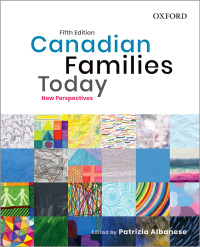Canadian Families Today, 5th Edition Patrizia Albanese
Original price was: $45.00.$34.97Current price is: $34.97.
Format: Downloadable ZIP File
Resource Type: Test bank
Duration: Unlimited downloads
Delivery: Instant Download
“Canadian Families Today, 5th Edition” by Patrizia Albanese is a comprehensive introduction to the sociology of family life in Canada. This fifth edition features contributions from top scholars in the field, providing an up-to-date analysis of the diverse nature of Canadian families. The book covers a wide range of topics, from historical perspectives on Canadian families to contemporary issues faced by immigrant and Indigenous families. With revised chapters on LGBTQI families, parenting, separation, and divorce, this edition offers a refreshed and insightful look at family dynamics in Canada.
**Key Details:**
– Title: Canadian Families Today, 5th Edition
– Author: Patrizia Albanese
– ISBN-13: 9780199039678
**Contents:**
The book is divided into four parts:
– Part I: Historical and theoretical overview of Canadian families
– Part II: Changes in families over the life course
– Part III: Issues in family life and challenges faced by specific family types
– Part IV: Family violence, family policies in Canada, and the future of the Canadian family
**Table of Contents:**
1. Introduction to Diversity in Canada’s Families
2. Canada’s Families
3. 2SLGBTQI+ Families in Canada
4. Intimacy, Commitment, and Family Formation
**Updated Content:**
This edition includes fully revised chapters, updated statistics, and refreshed content throughout. The book delves into topics such as rituals, paid and unpaid work, poverty, immigrant and refugee families, Indigenous families, and families living with disabilities.
**FAQs:**
1. **Is this book suitable for students studying sociology or family studies?**
– Yes, this book is an excellent resource for students interested in sociology, family studies, or Canadian social issues.
2. **Does the book cover contemporary challenges faced by Canadian families?**
– Absolutely, the fifth edition provides insights into current issues such as LGBTQI families, immigrant and refugee families, and family violence.
3. **Are there discussion questions and further readings included in the book?**
– Yes, each chapter includes research questions, additional readings, and suggested websites for further exploration of the topics discussed.
**Conclusion:**
“Canadian Families Today, 5th Edition” offers a detailed and contemporary analysis of the evolving nature of families in Canada. With a focus on diversity, challenges, and future trends, this book provides valuable insights for students, scholars, and anyone interested in understanding the complexities of family life in Canadian society.In the study of family dynamics and relationships, various topics are covered to understand the complexities of modern families. From the evolution of marriage to the challenges of parenting and the impact of separation and divorce, researchers delve into the intricacies of different family structures and societal norms. Let’s take a closer look at some of the key topics discussed in this field.
### Household Formation, Social Constructions, and Change
This section explores how households are formed, the influence of social constructions on family dynamics, and the changes that occur within households over time. It delves into the evolution of family structures and the factors that drive these changes.
### Intimacy: Meanings and Theories
The concept of intimacy in relationships is examined in this section, with a focus on the various meanings and theories that underpin intimate connections between individuals. Understanding intimacy is crucial in comprehending the dynamics of personal relationships within families.
### Marriage Debates: Authorized Constructions and Cultural Privilege
Marriage is a central institution in many societies, and this section delves into the debates surrounding the authorized constructions of marriage and the cultural privileges associated with it. It discusses how societal norms shape the institution of marriage and the debates surrounding it.
### Separation and Divorce
The impact of separation and divorce on individuals and families is a significant area of study in family dynamics. This section looks at the historical, legal, and social contexts of divorce, patterns of separation in different societies, and the multifaceted consequences of marital dissolution on children and adults.
### Families in Center and Later Life
As families evolve over time, this section explores what aging families look like, the transitions they go through, and the dynamics that shape familial relationships in middle and later life. It also examines the diversity in family structures and perspectives based on ethnicity, gender, and sexual orientation.
### Conclusion
In conclusion, the study of family issues is essential for understanding the complexities of human relationships and societal norms. By examining topics such as household formation, parenting challenges, divorce patterns, and aging family dynamics, researchers gain insights into the various factors that influence family structures and interactions.
Understanding these key themes in family dynamics sheds light on the intricate relationships and societal constructs that shape our lives and the way we perceive family units.
### FAQ
#### What are some common research questions in the study of family dynamics?
– Research questions in family dynamics may focus on topics such as the impact of societal norms on family structures, the role of technology in changing family dynamics, the effects of divorce on children, and the challenges faced by aging families.
#### How do societal norms influence family dynamics?
– Societal norms play a significant role in shaping family structures, relationships, and behaviors. They dictate traditional gender roles, expectations within marriages, and cultural beliefs about parenting, which in turn impact how families interact and function.
#### Why is the study of family dynamics important?
– Understanding family dynamics is crucial for addressing social issues, improving family relationships, and developing effective policies that support diverse family units. By studying topics such as marriage, parenting, divorce, and aging, researchers gain insights into the complexities of modern family life.
### Conclusion
In conclusion, the study of family dynamics offers valuable insights into the intricate web of relationships, social constructions, and cultural norms that shape modern families. By exploring topics such as household formation, intimacy theories, marriage debates, divorce patterns, and aging family dynamics, researchers deepen their understanding of the complexities inherent in family life. Through dedicated research and analysis, we can gain a deeper appreciation of the challenges and opportunities that families face in today’s ever-evolving society.# Chapter Titles: A Glimpse into the Diverse Topics Covered in Sociology Books
Sociology is a fascinating field that delves into the study of human societies, relationships, and behaviors. Let’s take a look at some of the intriguing chapter titles found in Sociology books that touch upon various aspects of life and culture.
## 8 Marriage and Demise Rituals
– **Introduction:** An overview of the chapter on marriage and demise rituals.
– **Pre-wedding Rituals:** Exploring the customs and traditions leading up to weddings.
– **Weddings within the Previous:** A historical perspective on marriage ceremonies.
– **Evolution of Weddings by way of the Twentieth Century:** Tracing the changes in wedding customs over the past century.
– **Weddings within the Twenty-First Century:** Modern trends and practices in weddings.
– **Various Approaches:** Diverse cultural approaches to marriage rituals.
– **Honeymoons:** The significance of post-wedding trips for couples.
– **Renewing Vows: A Ceremony of Development:** The symbolism behind renewing wedding vows.
– **Rites of Separation:** Exploring the rituals associated with the end of a marriage.
– **Conclusion:** Wrapping up the chapter on marriage and demise rituals.
## 9 Paid and Unpaid Work
– **Introduction:** An introduction to the concept of paid and unpaid labor.
– **Paid Work:**
– Gender and Paid Work
– Gender and Wages for Paid Work
– Gender and Half-time Work
– The Rise of Non-standard Employment
– **Unpaid Work:**
– Housekeeping
– Unpaid Care Work (Childcare)
– Care Tasks
– **Neighborhood and Inter-household Work:** Exploring community-based work dynamics.
– **Learning Paid and Unpaid Work:** Educational aspects related to work.
– **Connections between Paid and Unpaid Work:** Understanding the interaction between paid and unpaid labor.
– **Connections between Paid and Unpaid Work and State Insurance policies:** Examining the influence of policies on labor practices.
– **Gender Variations in Paid and Unpaid Work: What Distinction Does Distinction Make?** An analysis of gender disparities in labor.
– **Conclusion:** Summarizing the chapter on paid and unpaid work.
## 10 The Correlates and Coping Methods of Families Experiencing Poverty in Canada
– **Introduction:** Setting the stage for discussions on poverty in Canadian families.
– **Has the Downside of Poverty Worsened in Latest Many years?** Examining trends in poverty levels.
– **Shifts over Time Utilizing Statistics Canada’s LICO:** Utilizing statistical data to analyze poverty trends.
– **Low Earnings, Household Kind, and Variety of Earners:** Factors influencing poverty rates.
– **Poverty amongst Families in Later Life:** Understanding poverty among elderly populations.
– **How Do Low-Income Families Deal with Poverty?** Coping mechanisms adopted by families facing financial hardships.
– **What Are the Penalties of Poverty?** Exploring the repercussions of living in poverty.
– **Conclusion:** Concluding insights on poverty within Canadian families.
## FAQ
### What are the key themes covered in Sociology books?
Sociology books cover a wide range of topics such as family dynamics, gender roles, social structures, economic inequalities, cultural practices, and more.
### How can Sociology books help in understanding societal issues?
Sociology books provide a critical lens through which readers can analyze and comprehend complex societal issues, offering insights into human behavior and relationships.
### Are there practical applications of Sociology in real life?
Yes, sociology theories and concepts can be applied in various fields such as social work, public policy, education, business management, and community development to address social challenges and promote positive change.
## Conclusion
Exploring the diverse chapter titles in Sociology books gives us a glimpse into the multifaceted nature of human societies and interactions. From marriage rituals to labor dynamics and poverty issues, each chapter sheds light on different aspects of life that shape our experiences and relationships in society. Sociology continues to be a dynamic field that offers valuable insights into the complexities of the human experience.Investing in Families and Kids: How Canada’s Policies Impact Child Well-being
Introduction
Investing in families and children is crucial for the well-being and development of societies. In Canada, various family and child-related policies have been implemented to support families and ensure the welfare of children. From maternity and parental leave benefits to targeted child and family benefits, Canada has made significant investments in policies aimed at supporting families and children. This article will explore Canada’s family and child-related policies, examining their impact on child poverty, childcare, and the overall well-being of families.
Canada’s Family and Child-Related Policies
Maternity and Parental/Adoption Leave Benefits: Canada offers maternity and parental leave benefits to support parents in taking time off work to care for their newborn or adopted child. These benefits provide financial assistance to parents during their leave of absence from work, ensuring that they can focus on caring for their child without worrying about income loss.
From Universal to Targeted Child and Family Benefits: Canada has transitioned from universal child benefits to targeted benefits, aimed at providing targeted support to families in need. These benefits include the Canada Child Benefit (CCB), which is a tax-free monthly payment to eligible families to help with the cost of raising children.
Children in State Care: Canada has policies in place to support children in state care, ensuring that they have access to essential services and are provided with a safe and nurturing environment. These policies aim to protect the rights and well-being of children who are in need of care and protection.
Evaluation of Canada’s Child and Family Benefits
Impact on Child Poverty: The measures implemented by Canada, such as the CCB, have had a positive impact on reducing child poverty. By providing financial assistance to low-income families, these benefits help alleviate the financial strain on families and contribute to reducing child poverty rates.
Impact on Childcare: Canada’s investments in childcare have also had a significant impact on families. By providing subsidies and support for childcare services, Canadian families have more options for affordable and quality childcare, allowing parents to work or pursue other opportunities while their children are in safe and nurturing environments.
Quebec’s Family Policies: An Example to Follow
Quebec has been recognized for its progressive family policies, particularly its pro-natal policies aimed at supporting families in raising children. From pronatalism to pro-family measures, Quebec’s policies have focused on providing support to families through various initiatives and programs.
Looking Back, Looking Forward
As Canada continues to invest in families and children, it is essential to evaluate the effectiveness of these policies and make necessary adjustments to ensure that they meet the evolving needs of families. By learning from successful examples like Quebec’s family policies, Canada can further enhance its support for families and children.
Conclusion
Investing in families and children is a vital component of a thriving society. Canada’s family and child-related policies play a significant role in supporting families, reducing child poverty, and promoting the well-being of children. By evaluating the impact of these policies and learning from successful models, Canada can continue to improve and enhance its support for families and children.
Frequently Asked Questions (FAQs)
Q: What are some of the key family and child-related policies in Canada?
A: Some key policies in Canada include maternity and parental leave benefits, the Canada Child Benefit, and support for children in state care.
Q: How do Canada’s policies impact child poverty?
A: Canada’s policies, such as the Canada Child Benefit, have helped reduce child poverty rates by providing financial assistance to low-income families.
Q: What is the significance of Quebec’s family policies?
A: Quebec’s family policies are recognized for their focus on supporting families through pro-natal measures and initiatives aimed at enhancing the well-being of children.
Q: How can Canada improve its support for families and children?
A: Canada can enhance its support by evaluating the effectiveness of existing policies, learning from successful examples, and making necessary adjustments to meet the evolving needs of families.
In summary, investing in families and children is essential for building a strong and resilient society. Canada’s family and child-related policies demonstrate a commitment to supporting families, reducing child poverty, and promoting the well-being of children. By continuing to invest in these policies and learning from successful models, Canada can further enhance its support for families and children.The provided content outlines the table of contents for a book discussing the future of families and marriages. It delves into various aspects such as the disintegration of families, communal family structures, gender roles, sexuality, divorce and cohabitation, fertility management, and the impact of societal changes on families. This comprehensive guide aims to explore how families may evolve and adapt to changing societal norms and technologies.
### FAQ
**1. What is the main focus of the book on the future of families and marriages?**
The book primarily focuses on predicting the future of families and marriages as institutions, exploring various trends and changes that may impact them.
**2. What are some of the key topics covered in the book?**
Some key topics covered in the book include the disintegration of families, communal family structures, gender roles, sexuality, divorce and cohabitation trends, fertility management, and the influence of new reproductive and genetic technologies.
**3. How does the book discuss the impact of societal changes on families?**
The book examines how global and societal changes, such as increased immigration rates, Indigenous population growth, and changing demographic trends, may influence the structure and dynamics of families.
**4. Are there any predictions made about the future of Canadian families in the book?**
Yes, the book makes some tentative predictions about the future of Canadian families, considering the influence of international changes on domestic family structures.
### Conclusion
In conclusion, the book provides a thought-provoking analysis of the possible trajectories that families and marriages may take in the future. By exploring a wide range of topics and making predictions based on current trends and societal shifts, it offers valuable insights into how families may evolve and adapt in the coming years. This comprehensive guide is essential reading for anyone interested in understanding the changing dynamics of family life in the modern world.
—
To summarize, the book on the future of families and marriages covers a wide range of topics such as changing family structures, gender roles, and the impact of societal changes. It offers predictions and insights into how families may transform in the face of evolving societal norms and technological advancements.
User Reviews
Be the first to review “Canadian Families Today, 5th Edition Patrizia Albanese”

Original price was: $45.00.$34.97Current price is: $34.97.






There are no reviews yet.